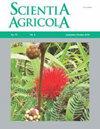番茄果实斑点病毒的细胞病理学加强了植物紫色病毒和昆虫阴性病毒之间的进化联系
IF 2.6
3区 农林科学
Q1 Agricultural and Biological Sciences
引用次数: 1
摘要
:番茄果实斑病病毒(ToFBV)是一种紫色病毒,2020年在意大利和澳大利亚的成熟番茄果实上引起斑点,最近在巴西被发现。在巴西Brasília收集的受感染水果的斑点区对果皮组织进行细胞学研究,揭示了特征性的细胞改变。在表皮、果皮周围和中果皮细胞的核周间隙和内质网腔中,发现了小而细长的芽孢杆菌状颗粒(约25 nm宽× 100 nm长)。细胞核和细胞质中均未见病毒质样包涵体。这种细胞变化让人想起那些被阴性病毒(一种非官方的昆虫病毒)感染的培养蚊子细胞。阴性病毒和其他一些节肢动物传播的病毒与基塔病毒(包括布鲁纳病毒)在RdRp基因中有共同的祖先。虽然还需要进一步的详细研究,但我们证明了ToFBV颗粒是包裹的和杆菌状的,并且细胞病理学上的这种相似性似乎支持了植物kitaviv和昆虫阴性病毒之间的进化关系。本文章由计算机程序翻译,如有差异,请以英文原文为准。
Tomato fruit blotch virus cytopathology strengthens evolutionary links between plant blunerviruses and insect negeviruses
: Tomato fruit blotch virus (ToFBV) is a blunervirus that causes blotches on mature tomato ( Solanum lycopersicon L.) fruits in Italy and Australia in 2020, and was newly detected in Brazil. A cytological study on pericarp tissues from the blotched areas of infected fruits collected in Brasília, Brazil, revealed characteristic cell alterations. Small and slender bacilliform particles (ca. 25 nm wide × 100 nm long) were found accumulating in the perinuclear space and the lumen of the endoplasmic reticulum of the epidermis, peri- and mesocarp cells. No viroplasm-like inclusion was observed either in the nuclei or in the cytoplasm. Such cell alterations are reminiscent of those described in cultured mosquito cells infected by negeviruses, an unofficial group of insect viruses. Negeviruses and some other arthropod-borne viruses shared a common ancestor in the RdRp gene with kitavirids, including blunerviruses. Although additional detailed studies are required, we show evidence that ToFBV particles are enveloped and bacilliform, and that such similarity in cytopathology seems to support the evolutionary relationship between plant kitavirids and insect negeviruses.
求助全文
通过发布文献求助,成功后即可免费获取论文全文。
去求助
来源期刊

Scientia Agricola
农林科学-农业综合
CiteScore
5.10
自引率
3.80%
发文量
78
审稿时长
18-36 weeks
期刊介绍:
Scientia Agricola is a journal of the University of São Paulo edited at the Luiz de Queiroz campus in Piracicaba, a city in São Paulo state, southeastern Brazil. Scientia Agricola publishes original articles which contribute to the advancement of the agricultural, environmental and biological sciences.
 求助内容:
求助内容: 应助结果提醒方式:
应助结果提醒方式:


